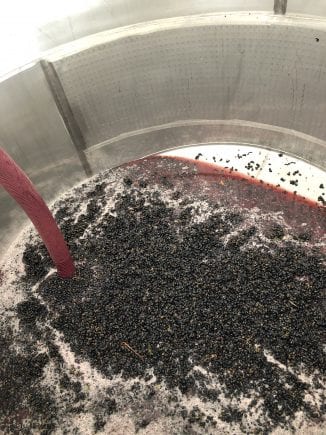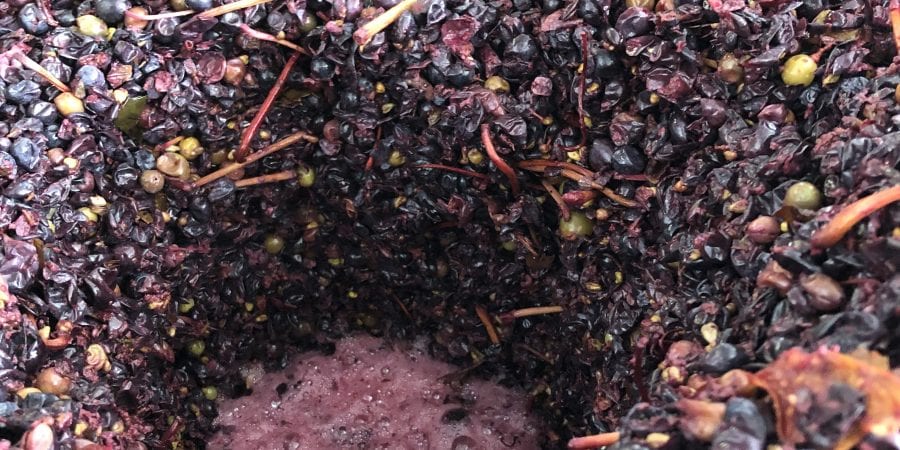Now, I am aware that I’ve touched on this topic in the past… maybe even a couple of times. But not only do we have new readers (welcome!), but I’m going to delve a bit deeper this time around.
And it also serves as a quick reminder as we’re now well and truly into the fermentation section of Vintage 2021.
All of our fruit has been picked and in the winery fermenting away (some of them have even finished fermentation). So, let’s remind ourselves of the basics…
Primary fermentation
Primary fermentation is the conversion of the sugar in the grape juice to alcohol and carbon dioxide by specifically selected yeast.
So, for those of you who like a good equation…
Sugar (grape juice) + yeast = alcohol + gas
The strain of yeast selected by the winemaker is based both on its ability to conduct the fermentation efficiently and also on the sensory features they add to the wine. For example, some yeasts produce compounds which add to the fruity and estery characters of the wine. While others are more neutral, allowing greater expression of the specific characters of each variety.
Fun fact: at the peak of fermentation there will be around 100 million yeast cells in one ml of the fermenting liquid!
Just quickly, before I go on… some winemakers chose not to inoculate their grape juice with a specific strain of yeast. They prefer to use a technique called “wild-fermentation” which means they let the fermentation proceed using only the yeast found naturally on the grapes, in the vineyard and winery.
…but that’s a topic for another day!
Now, where were we?
White wines
White wines are usually fermented in temperature-controlled stainless steel tanks or in barrels stored in a cold room to regulate the temperature. The aim is to keep the fermentation at between 8 and 18°C. This helps to keep the varietal aromas and flavours of the grapes in the finished wine.
Fermentation of dry white table wines is allowed to continue until all the sugar is converted to alcohol. In sweet wines, however, the fermentation is stopped part of the way through (by cooling the wine below 8°C) to leave some of the sugar unfermented.
Winemakers measure the amount of sugar in the wine on a daily basis during fermentation. They need to ensure that the fermentation is progressing at a steady rate. This is usually done using a hydrometer and is expressed in degrees Baumé (Bé°). While this form of measurement isn’t 100% spot on, it’s quick and easy. And it’s good enough when it comes to tracking the progress of the ferment.
Once the ferment looks like it is close to being finished (0 Bé° for dry wines), winemakers use more accurate (tricky and time-consuming!) measurements to ensure all of the sugar has been consumed by the yeast.
On the completion of fermentation, white wines are either stored in stainless steel tanks (and then bottled) or aged in oak barrels.
Red wines
Temperature
Fermentation at a cool temperature (below 20°C) retains fruit characters. It also limits the extraction of colour and tannins from the skins as well as bitter tannins from the seeds.
Higher fermentation temperatures (above 20°C) are required to extract more flavour, colour and tannins from the skins.
This is easy to control if you’re making a large quantity and you have a fancy stainless steel, temperature-controlled tank. Many red wines though are made in open fermenters (big plastic tubs!) and there are a few tricky techniques used to maintain the desired temperature. Usually in the Hills, keeping them cool enough isn’t much of a problem! Although popping the fermenter into a cold room for a few hours usually does the trick. Heat is created by the fermentation itself, but if it needs encouraging a nice sunny spot outside can help!
Maceration techniques
 As the fermentation progresses, the carbon dioxide produced pushes the mixture of skins and seeds (the cap) to the top of the fermenting liquid. The alcohol produced in the wine helps to extract the colour from the skins. Therefore, the cap must be kept in contact with the liquid by frequent mixing.
As the fermentation progresses, the carbon dioxide produced pushes the mixture of skins and seeds (the cap) to the top of the fermenting liquid. The alcohol produced in the wine helps to extract the colour from the skins. Therefore, the cap must be kept in contact with the liquid by frequent mixing.
There are a couple of ways to do that, but here are the two most common…
- Pumping over: as the name suggests, is simply the process of pumping liquid from the bottom of the tank and splashing it over the top of the cap. As the liquid leaches through the cap, it extracts the colour from the skins.
- Plunging down: this one is sort of the opposite of pumping over. Grab a big over-sized potato masher (or “plunger” to be more specific) and use those muscles to push the cap down into the liquid. Easy! Unless of course, the fermenter is big enough that you need to stand on a plank of wood suspended above it and you accidentally fall in. Ask Rob for a first-hand account!
Just like the white wines, the sugar content of red wines is monitored throughout the fermentation to determine when the wine is dry (or has no sugar and is therefore complete).
There is another consideration for winemakers during the fermentation of red wines though…
How long to keep it “on skins”.
Time on skins
A short time on skins produces lighter coloured, more fruity style wines. Longer skin contact increases flavour, colour and tannin extraction.
At fermentation temperatures around 25°C, most of the flavour and colour is extracted from the skins by about midway through the fermentation, while tannin extraction continues for as long as the skins and seeds are kept in contact with the liquid. When the winemaker decides that the right balance between flavour, colour and tannin has been reached, the partly fermented wine will be pressed off skins and the fermentation allowed to continue.
OK, so I think that pretty much covers primary fermentation. Check in again next week when I’ll recap secondary fermentation.
